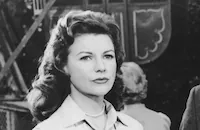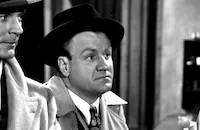George White's Scandals

Brief Synopsis
Cast & Crew
Felix E. Feist
Joan Davis
Jack Haley
Phillip Terry
Martha Holliday
Ethel Smith, <i>swing Organist</i>
Film Details
Technical Specs

Synopsis
At a twenty-sixth reunion of the Scandals Club, an organization comprised of women performers of the George White's Scandals show, comedienne Joan Mason announces her engagement to Scandals performer Jack Evans. As the women congratulate Joan, Jill Asbury, the daughter of former Scandals dancer Molly Hogan, approaches the group to introduce herself. Jill's mother left the show to marry Lord Asbury, an English nobleman, and for old time's sake, Joan invites the girl to attend the show's rehearsal. Joan's prospect for marriage dims when Jack introduces her to his spinster sister Clarabelle, who disapproves of Joan and reminds her brother of the promise that he made at his mother's death bed to postpone marrying until she achieved wedded bliss. At rehearsals the next day, Tom McGrath, the show's manager, mistakes Jill for one of the chorus girls. Smitten by Tom, Jill pretends to be Jill Martin, a struggling dancer, and asks Joan to keep her secret. When Joan warns Jill that Tom treats the chorus girls like sisters, she embarks upon a campaign to win his interest by appealing to his brotherly instincts. Meanwhile, Joan determines to marry off Clarabelle and arranges a date for her through an escort service. Jack has planned a surprise birthday party for his sister that night, and all of the show's performers gather at the Evans house to entertain. At the party, Billie Randall, one of the dancers, becomes jealous when Tom kisses Jill. Clarabelle is flattered by the attentions of her date, M. Montescu, until she discovers that Joan hired him through an escort service. After Clarabelle hurls an ax at her, Joan despairs of ever winning her approval and decides to call off the engagement. At rehearsals the next day, George White is so impressed by Jill's dancing that Tom suggests offering her the closing spot, which is coveted by Billie. When a jealous Billie learns Jill's real identity, she calls the British Embassy. Lord Quimby, a representative of the Embassy, is scandalized about Jill's appearance in the show and comes to the theater to persuade her to withdraw. When Tom learns that Jill has deceived him about her identity, he becomes enraged and Jill runs away. On opening night, Tom begins to search for her, and Jack tells Clarabelle that he plans to marry Joan over her objections. Clarabelle then goes to the theater to complain to Mr. White, and is knocked unconscious by a falling sandbag. Molly and her husband, Lord Asbury, go backstage before the show to tell Mr. White that they are thrilled about their daughter's appearance in the show, and he informs them about Jill's disappearance. During a mind reading act, Jack spots Jill in the audience, and when she sees her parents proudly sitting in their box seats, she goes backstage, reconciles with Tom and takes the stage in time to perform her ballet number. All ends happily when Clarabelle awakens after the performance and begins to sing Joan's praises.

Director
Felix E. Feist
Cast

Joan Davis

Jack Haley

Phillip Terry

Martha Holliday
Ethel Smith, <i>swing Organist</i>

Margaret Hamilton
Glenn Tryon

Bettejane Greer
Audrey Young
Rose Murphy

Fritz Feld
Beverly Wills
Gene Krupa
Rufe Davis
Wesley Brent
Grace Young
Lorraine Clark
Diana Mumby
Linda Claire
Susanne Rosser
Marilyn Buford
Marie Mccardle
Vivian Mason
Vivian Mccoy
Virginia Belmont
Rusty Farrell

Nan Leslie
Chili Williams
Tanis Chandler
June Frazer
Virginia Cruzon
Annelle Hayes
Joy Barlowe
Barbara Thorson

Ruth Hall
Ethelreda Leopold
Alice Eyland
Linda Ennis
Lucy Cochrane
Zaz Vorka
Betty Farrington
Judith Levinson
Larry Wheat
Harold Minjir
Rosalie Ray

Tom Noonan
Edmund Glover
Sammy Blum
Nino Tempo
Shelby Bacon
Edwin Davis
Edwin Johnson
Bob Mascagno
John Stanley
Allan Cooke
Eric Freeman
Vonn Hamilton
Walter Stone
Tom Ladd
Ronnie Marvin
Florence Lake
Minerva Urecal
Crane Whitley
Effie Laird

Hope Landin
Mary Currier

Dorothy Sebastian
Leone Souza
Eddie Dunn
Bobby Barber
Tom Coleman
Donald Kerr
Earl Dewey
Leo Borden

Carmel Myers
Neely Edwards
Ed O'neill
Jerome Franks Jr.

Sidney Melton
Allan Watson
Patti Nelson
Dorothy Christy

Holmes Herbert
Harry Monty
Buster Brodie
Joe Oakie
Frank Mitchell

Lyle Latell
Frank Mitchell
Herbert Evans
Barbara Slater
Ruth Brennan
Dagmar Oakland
Flo Wix
Louise Bates
Warren Jackson
Paul Gustine
Phil Jones
Curtis Hamilton
Crew
C. Bakaleinikoff
Clem Beauchamp
Norman Bennett
Ralph Berger
Lew Brown
Carroll Clark
Albert S. D'agostino
Sammy Fain
Fred A. Fleck
George Gershwin
Robert De Grasse
Howard J. Green
Jack J. Gross
Leigh Harline
Ray Henderson
Nat Holt
Gene Krupa
Parke Levy
Ernst Matray
Harley Miller
Joseph Noriega
Harold Palmer
Darrell Silvera
Howard Snyder
Howard Snyder
Jean L. Speak
Edward Stevenson
James G. Stewart
Vernon L. Walker
Hugh Wedlock
Hugh Wedlock
George White
Jack Yellen

Videos
Movie Clip




Trailer
Film Details
Technical Specs

Articles
George White's Scandals (1945),
A decade later, White was able to mount a third film, this time at RKO and therefore without Alice Faye, who was still under contract to Fox. Like the first two, this 1945 edition makes due with a minimal plot, functioning instead as a sketchy framework to enable lots of musical numbers to be delivered in the style of a revue. There are, in fact, twelve production numbers here of all kinds, including a comic skit entitled "Who Killed Vaudeville?" which Variety deemed "uproarious," a ballet number called "Bouquet and Lace," and several more modern songs performed by famed drummer Gene Krupa and his band, like "Bolero in the Jungle," "Leave Us Leap," and "I Want to be a Drummer in the Band."
Toplining the cast are Jack Haley and Joan Davis. Haley was a popular comic star, particularly in vaudeville, and is best known to movie fans as the Tin Man in The Wizard of Oz (1939). Davis, virtually forgotten today, was a very well-liked comedienne of the 1940s and '50s on radio, film and television. Her real-life daughter Beverly Wills, age twelve, portrays a child version of Davis's character in this film, in "Life is Like a Bowl of Cherries." That number had been featured in White's 1931 edition of his stage show and as such, it provides something of an interesting look into the Scandals' past.
Look for Jane Greer in only her second credited film. She's billed as "Bettejane Greer." Starting with her next assignment, Dick Tracy (1945), she would go by "Jane Greer."
Aside from Jack Haley, there's another Wizard of Oz veteran in the cast, too: Margaret Hamilton. The Wicked Witch herself is here memorably told at one point, "There's a limit to how much of your type of beauty a man can stand, and I'm rapidly reaching the limit."
Producer: George White
Director: Felix E. Feist
Screenplay: Howard Green, Peter Levy; Howard Snyder, Hugh Wedlock (both story)
Cinematography: Robert de Grasse
Art Direction: Ralph Berger, Albert S. D'Agostino
Film Editing: Joseph Noriega
Cast: Joan Davis (Joan Mason), Jack Haley (Jack Evans), Phillip Terry (Tom McGrath), Martha Holliday (Jill Martin), Ethel Smith (swing organist), Margaret Hamilton (Clarabelle Evans), Glenn Tryon (George White), Bettejane Greer (Billie Randall), Audrey Young (Maxine Manner), Rose Murphy (Hilda, Joan's maid), Fritz Feld (Montescu).
BW-96m.
by Jeremy Arnold

George White's Scandals (1945),
Quotes
Trivia
Notes
The working title of this film was George White's Scandals of 1945. Beverly Will's credit read "Joan as a child played by Joan Davis' daughter Beverly Wills." According to a Hollywood Reporter news item, the musical number "Life Is Just a Bowl of Cherries" was filmed using a mirror trick devised by choreographer Ernst Matray in which six dancers appear as a chorus of sixty and two cherry trees look like an entire orchard. Another news item in Hollywood Reporter adds that the musical numbers were shot with three cameras, a technique which enabled the cameramen to film matte shots simultaneously with the various angles of the production numbers, thus saving time and negative film stock. This was Broadway producer George White's third film based on his highly successful series of theatrical musical revues which began in 1919. White's other films were the 1934 Twentieth Century-Fox production George White's Scandals, directed by White and starring Rudy Vallee, Jimmy Durante and Alice Faye and the 1935 Twentieth Century-Fox film George White's 1935 Scandals, also directed by White and starring Alice Faye, Ned Sparks and James Dunn (see AFI Catalog of Feature Films, 1931-40; F3.1565).

Miscellaneous Notes
Released in United States Summer August 1945
Released in United States Summer August 1945














